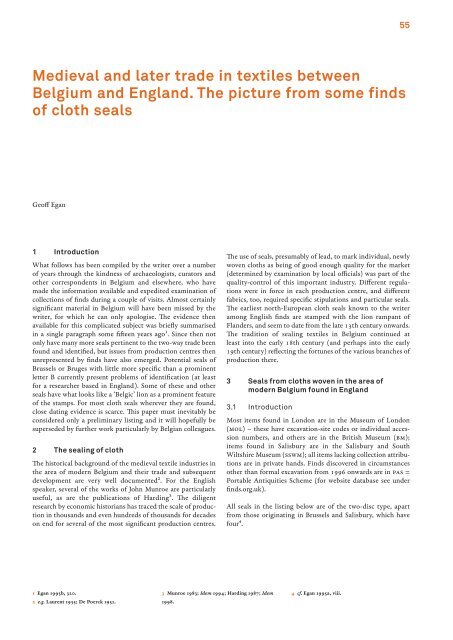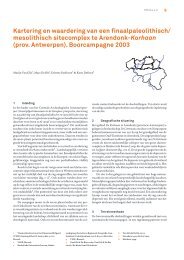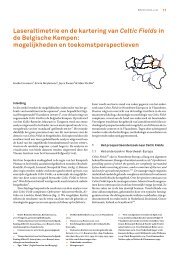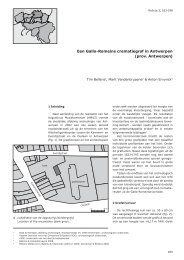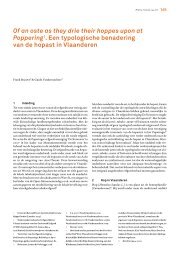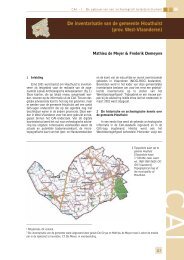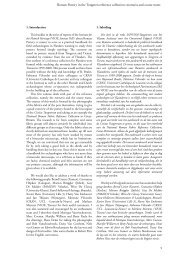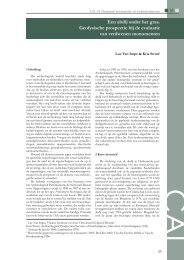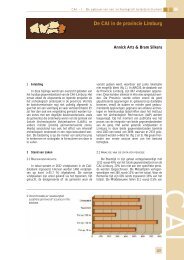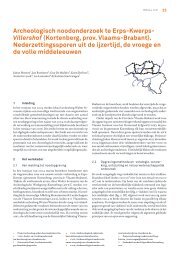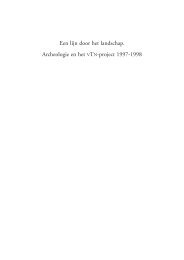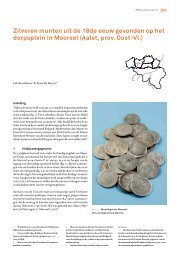Exchanging Medieval Material Culture Studies on archaeology and ...
Exchanging Medieval Material Culture Studies on archaeology and ...
Exchanging Medieval Material Culture Studies on archaeology and ...
You also want an ePaper? Increase the reach of your titles
YUMPU automatically turns print PDFs into web optimized ePapers that Google loves.
<str<strong>on</strong>g>Medieval</str<strong>on</strong>g> <strong>and</strong> later trade in textiles between<br />
Belgium <strong>and</strong> Engl<strong>and</strong>. The picture from some finds<br />
of cloth seals<br />
Geoff Egan<br />
1 Introducti<strong>on</strong><br />
What follows has been compiled by the writer over a number<br />
of years through the kindness of archaeologists, curators <strong>and</strong><br />
other corresp<strong>on</strong>dents in Belgium <strong>and</strong> elsewhere, who have<br />
made the informati<strong>on</strong> available <strong>and</strong> expedited examinati<strong>on</strong> of<br />
collecti<strong>on</strong>s of fi nds during a couple of visits. Almost certainly<br />
signifi cant material in Belgium will have been missed by the<br />
writer, for which he can <strong>on</strong>ly apologise. Th e evidence then<br />
available for this complicated subject was briefl y summarised<br />
in a single paragraph some fi ft een years ago1. Since then not<br />
<strong>on</strong>ly have many more seals pertinent to the two-way trade been<br />
found <strong>and</strong> identifi ed, but issues from producti<strong>on</strong> centres then<br />
unrepresented by fi nds have also emerged. Potential seals of<br />
Brussels or Bruges with little more specifi c than a prominent<br />
letter B currently present problems of identifi cati<strong>on</strong> (at least<br />
for a researcher based in Engl<strong>and</strong>). Some of these <strong>and</strong> other<br />
seals have what looks like a ‘Belgic’ li<strong>on</strong> as a prominent feature<br />
of the stamps. For most cloth seals wherever they are found,<br />
close dating evidence is scarce. Th is paper must inevitably be<br />
c<strong>on</strong>sidered <strong>on</strong>ly a preliminary listing <strong>and</strong> it will hopefully be<br />
superseded by further work particularly by Belgian colleagues.<br />
2 The sealing of cloth<br />
Th e historical background of the medieval textile industries in<br />
the area of modern Belgium <strong>and</strong> their trade <strong>and</strong> subsequent<br />
development are very well documented2. For the English<br />
speaker, several of the works of John Munroe are particularly<br />
useful, as are the publicati<strong>on</strong>s of Harding3. Th e diligent<br />
research by ec<strong>on</strong>omic historians has traced the scale of producti<strong>on</strong><br />
in thous<strong>and</strong>s <strong>and</strong> even hundreds of thous<strong>and</strong>s for decades<br />
<strong>on</strong> end for several of the most signifi cant producti<strong>on</strong> centres.<br />
1 Egan 1995b, 320.<br />
2 e.g. Laurent 1935; De Poerck 1951.<br />
3 Munroe 1983; Idem 1994; Harding 1987; Idem<br />
1998.<br />
4 cf. Egan 1995a, viii.<br />
55<br />
Th e use of seals, presumably of lead, to mark individual, newly<br />
woven cloths as being of good enough quality for the market<br />
(determined by examinati<strong>on</strong> by local offi cials) was part of the<br />
quality-c<strong>on</strong>trol of this important industry. Diff erent regulati<strong>on</strong>s<br />
were in force in each producti<strong>on</strong> centre, <strong>and</strong> diff erent<br />
fabrics, too, required specifi c stipulati<strong>on</strong>s <strong>and</strong> particular seals.<br />
Th e earliest north-European cloth seals known to the writer<br />
am<strong>on</strong>g English fi nds are stamped with the li<strong>on</strong> rampant of<br />
Fl<strong>and</strong>ers, <strong>and</strong> seem to date from the late 13th century <strong>on</strong>wards.<br />
Th e traditi<strong>on</strong> of sealing textiles in Belgium c<strong>on</strong>tinued at<br />
least into the early 18th century (<strong>and</strong> perhaps into the early<br />
19th century) refl ecting the fortunes of the various branches of<br />
producti<strong>on</strong> there.<br />
3 Seals from cloths woven in the area of<br />
modern Belgium found in Engl<strong>and</strong><br />
3.1 Introducti<strong>on</strong><br />
Most items found in L<strong>on</strong>d<strong>on</strong> are in the Museum of L<strong>on</strong>d<strong>on</strong><br />
(mol) – these have excavati<strong>on</strong>-site codes or individual accessi<strong>on</strong><br />
numbers, <strong>and</strong> others are in the British Museum (bm);<br />
items found in Salisbury are in the Salisbury <strong>and</strong> South<br />
Wiltshire Museum (sswm); all items lacking collecti<strong>on</strong> attributi<strong>on</strong>s<br />
are in private h<strong>and</strong>s. Finds discovered in circumstances<br />
other than formal excavati<strong>on</strong> from 1996 <strong>on</strong>wards are in pas =<br />
Portable Antiquities Scheme (for website database see under<br />
fi nds.org.uk).<br />
All seals in the listing below are of the two-disc type, apart<br />
from those originating in Brussels <strong>and</strong> Salisbury, which have<br />
four4.


